Information Systems Fundamentals Report: Internet Access and FTTP
VerifiedAdded on 2022/09/18
|8
|1158
|18
Report
AI Summary
This report, focusing on Information Systems Fundamentals, explores the state of internet access and telecommunications in Australia. It begins by analyzing the proportion of households with internet access in Queensland and NSW, followed by a discussion of the benefits of digital services and the impact of socio-demographic factors on internet accessibility. The report then delves into the issue of mobile blackspots in Australia, examining the initiatives taken by major mobile network providers. Finally, it provides an overview of Fibre to the Premises (FTTP) technology and its potential benefits, particularly for education and healthcare. The report uses data to analyze the internet accessibility and FTTP, making this report a comprehensive overview of the current state of information systems in Australia.
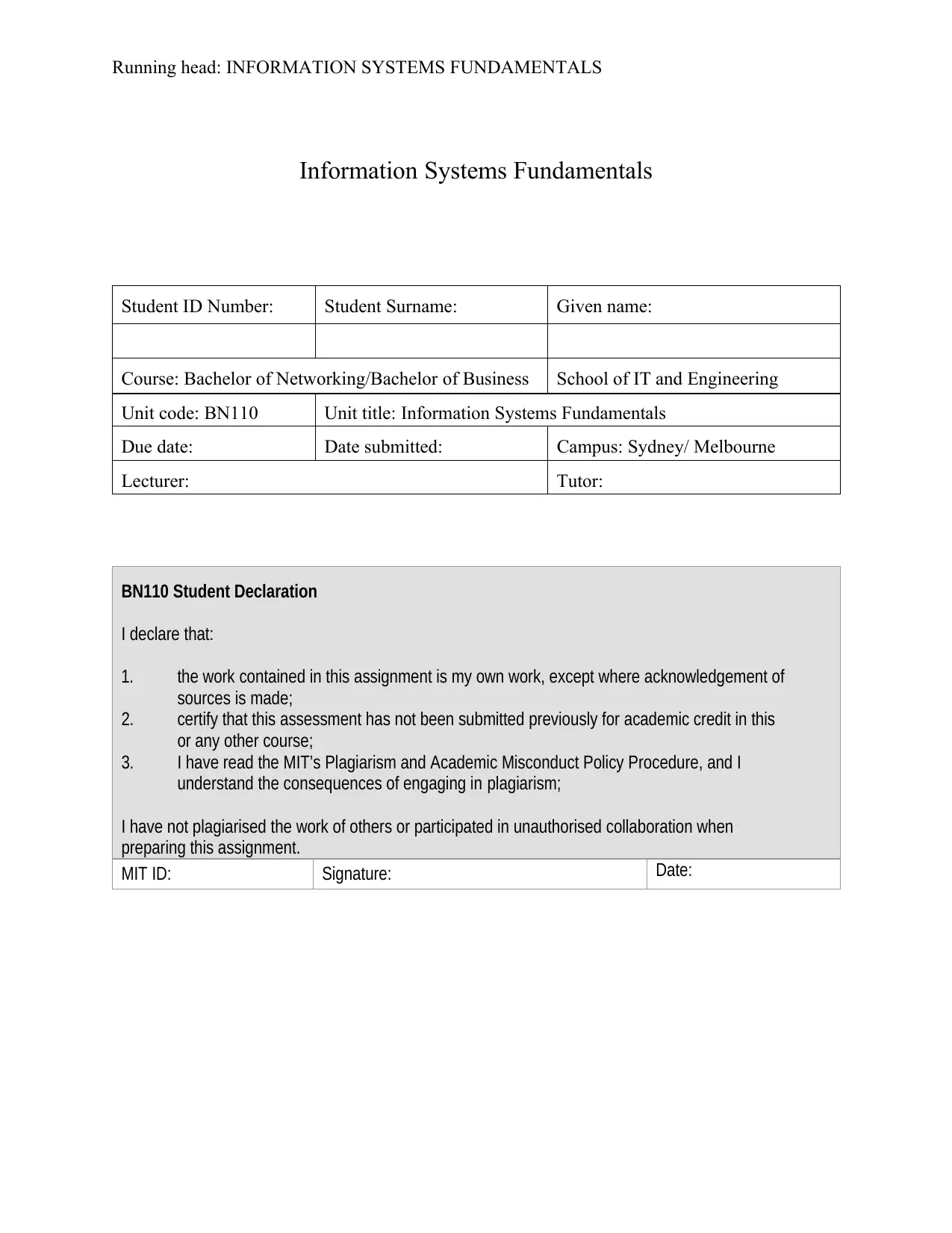
Running head: INFORMATION SYSTEMS FUNDAMENTALS
Information Systems Fundamentals
Student ID Number: Student Surname: Given name:
Course: Bachelor of Networking/Bachelor of Business School of IT and Engineering
Unit code: BN110 Unit title: Information Systems Fundamentals
Due date: Date submitted: Campus: Sydney/ Melbourne
Lecturer: Tutor:
BN110 Student Declaration
I declare that:
1. the work contained in this assignment is my own work, except where acknowledgement of
sources is made;
2. certify that this assessment has not been submitted previously for academic credit in this
or any other course;
3. I have read the MIT’s Plagiarism and Academic Misconduct Policy Procedure, and I
understand the consequences of engaging in plagiarism;
I have not plagiarised the work of others or participated in unauthorised collaboration when
preparing this assignment.
MIT ID: Signature: Date:
Information Systems Fundamentals
Student ID Number: Student Surname: Given name:
Course: Bachelor of Networking/Bachelor of Business School of IT and Engineering
Unit code: BN110 Unit title: Information Systems Fundamentals
Due date: Date submitted: Campus: Sydney/ Melbourne
Lecturer: Tutor:
BN110 Student Declaration
I declare that:
1. the work contained in this assignment is my own work, except where acknowledgement of
sources is made;
2. certify that this assessment has not been submitted previously for academic credit in this
or any other course;
3. I have read the MIT’s Plagiarism and Academic Misconduct Policy Procedure, and I
understand the consequences of engaging in plagiarism;
I have not plagiarised the work of others or participated in unauthorised collaboration when
preparing this assignment.
MIT ID: Signature: Date:
Paraphrase This Document
Need a fresh take? Get an instant paraphrase of this document with our AI Paraphraser
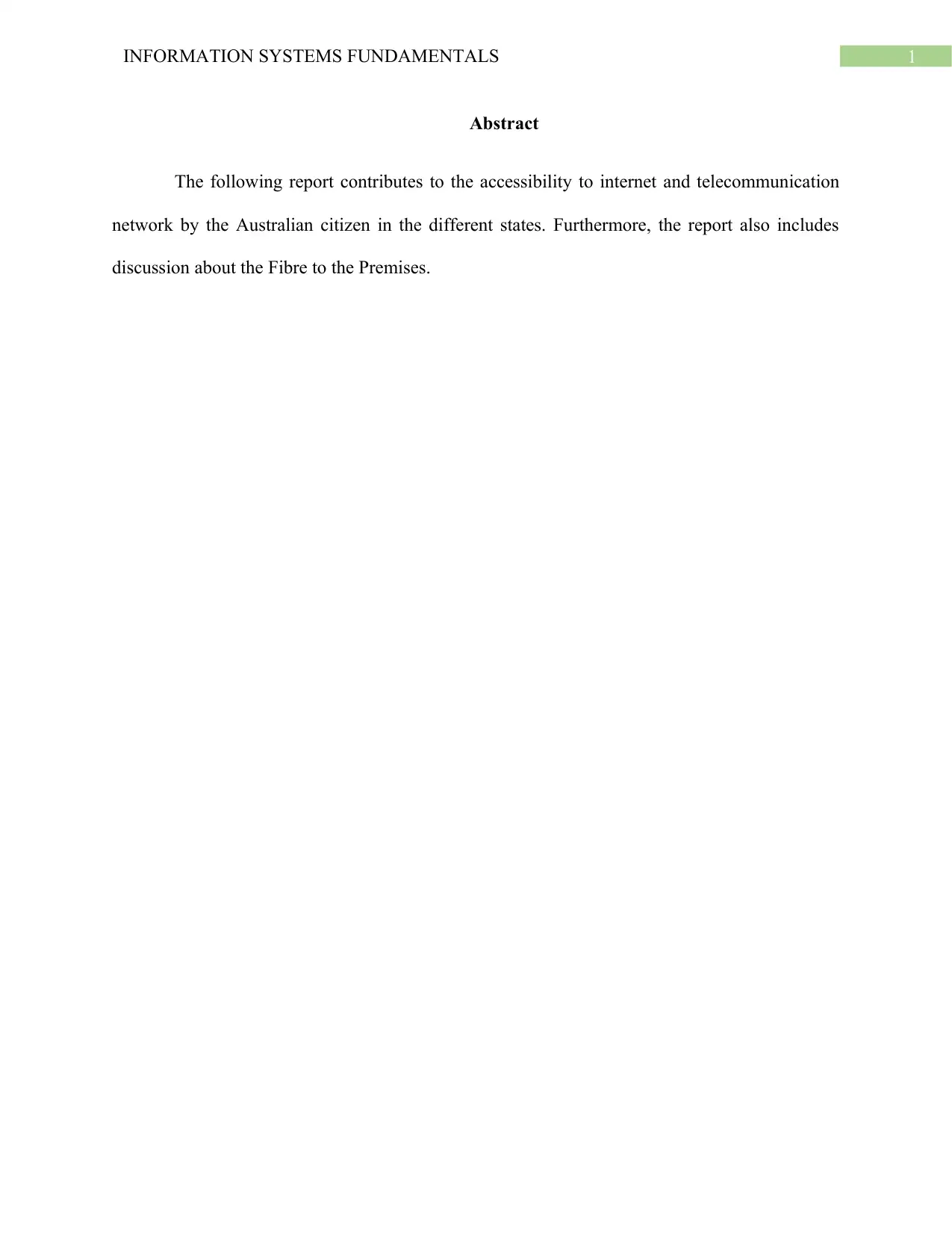
1INFORMATION SYSTEMS FUNDAMENTALS
Abstract
The following report contributes to the accessibility to internet and telecommunication
network by the Australian citizen in the different states. Furthermore, the report also includes
discussion about the Fibre to the Premises.
Abstract
The following report contributes to the accessibility to internet and telecommunication
network by the Australian citizen in the different states. Furthermore, the report also includes
discussion about the Fibre to the Premises.
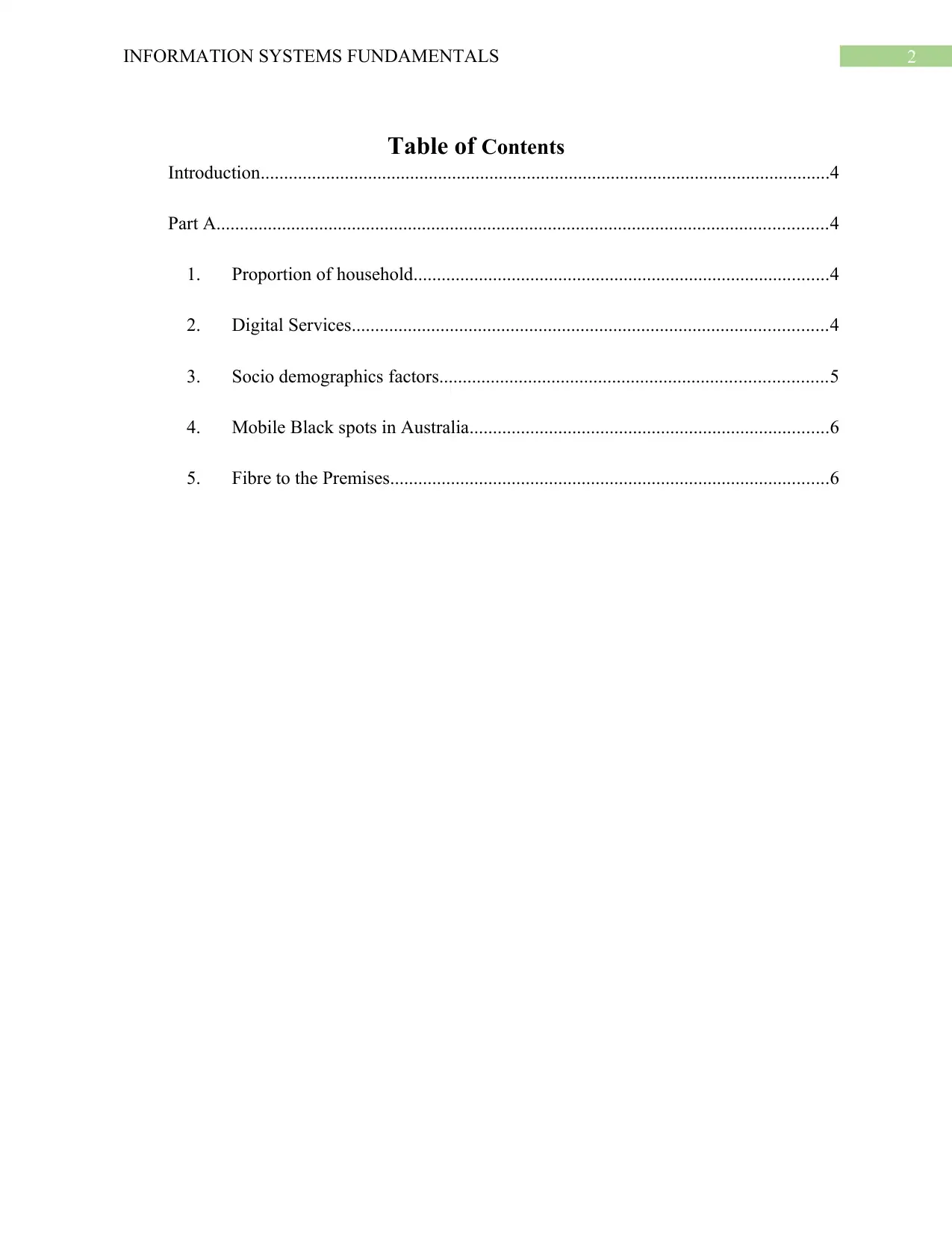
2INFORMATION SYSTEMS FUNDAMENTALS
Table of Contents
Introduction..........................................................................................................................4
Part A...................................................................................................................................4
1. Proportion of household.........................................................................................4
2. Digital Services......................................................................................................4
3. Socio demographics factors...................................................................................5
4. Mobile Black spots in Australia.............................................................................6
5. Fibre to the Premises..............................................................................................6
Table of Contents
Introduction..........................................................................................................................4
Part A...................................................................................................................................4
1. Proportion of household.........................................................................................4
2. Digital Services......................................................................................................4
3. Socio demographics factors...................................................................................5
4. Mobile Black spots in Australia.............................................................................6
5. Fibre to the Premises..............................................................................................6
⊘ This is a preview!⊘
Do you want full access?
Subscribe today to unlock all pages.

Trusted by 1+ million students worldwide
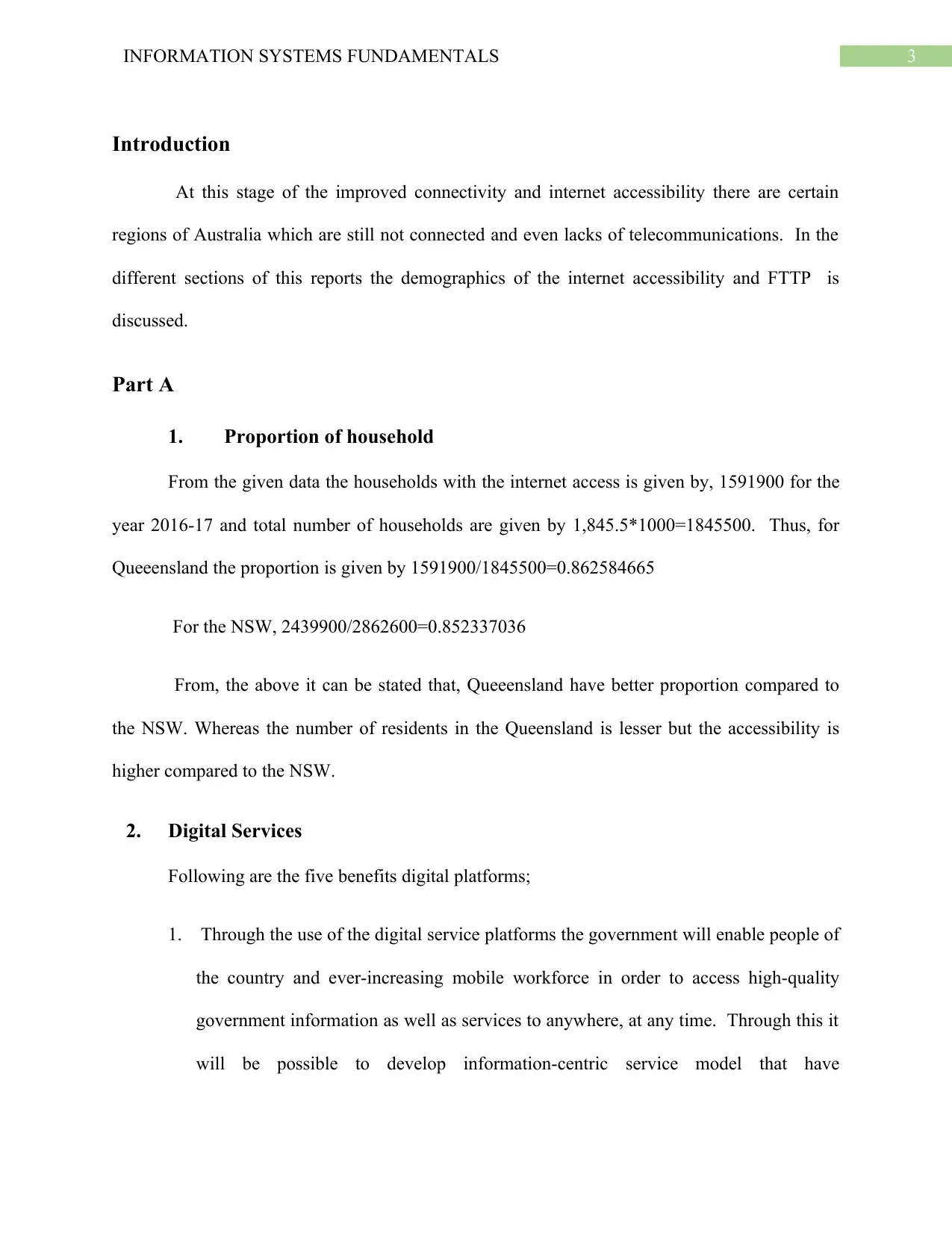
3INFORMATION SYSTEMS FUNDAMENTALS
Introduction
At this stage of the improved connectivity and internet accessibility there are certain
regions of Australia which are still not connected and even lacks of telecommunications. In the
different sections of this reports the demographics of the internet accessibility and FTTP is
discussed.
Part A
1. Proportion of household
From the given data the households with the internet access is given by, 1591900 for the
year 2016-17 and total number of households are given by 1,845.5*1000=1845500. Thus, for
Queeensland the proportion is given by 1591900/1845500=0.862584665
For the NSW, 2439900/2862600=0.852337036
From, the above it can be stated that, Queeensland have better proportion compared to
the NSW. Whereas the number of residents in the Queensland is lesser but the accessibility is
higher compared to the NSW.
2. Digital Services
Following are the five benefits digital platforms;
1. Through the use of the digital service platforms the government will enable people of
the country and ever-increasing mobile workforce in order to access high-quality
government information as well as services to anywhere, at any time. Through this it
will be possible to develop information-centric service model that have
Introduction
At this stage of the improved connectivity and internet accessibility there are certain
regions of Australia which are still not connected and even lacks of telecommunications. In the
different sections of this reports the demographics of the internet accessibility and FTTP is
discussed.
Part A
1. Proportion of household
From the given data the households with the internet access is given by, 1591900 for the
year 2016-17 and total number of households are given by 1,845.5*1000=1845500. Thus, for
Queeensland the proportion is given by 1591900/1845500=0.862584665
For the NSW, 2439900/2862600=0.852337036
From, the above it can be stated that, Queeensland have better proportion compared to
the NSW. Whereas the number of residents in the Queensland is lesser but the accessibility is
higher compared to the NSW.
2. Digital Services
Following are the five benefits digital platforms;
1. Through the use of the digital service platforms the government will enable people of
the country and ever-increasing mobile workforce in order to access high-quality
government information as well as services to anywhere, at any time. Through this it
will be possible to develop information-centric service model that have
Paraphrase This Document
Need a fresh take? Get an instant paraphrase of this document with our AI Paraphraser
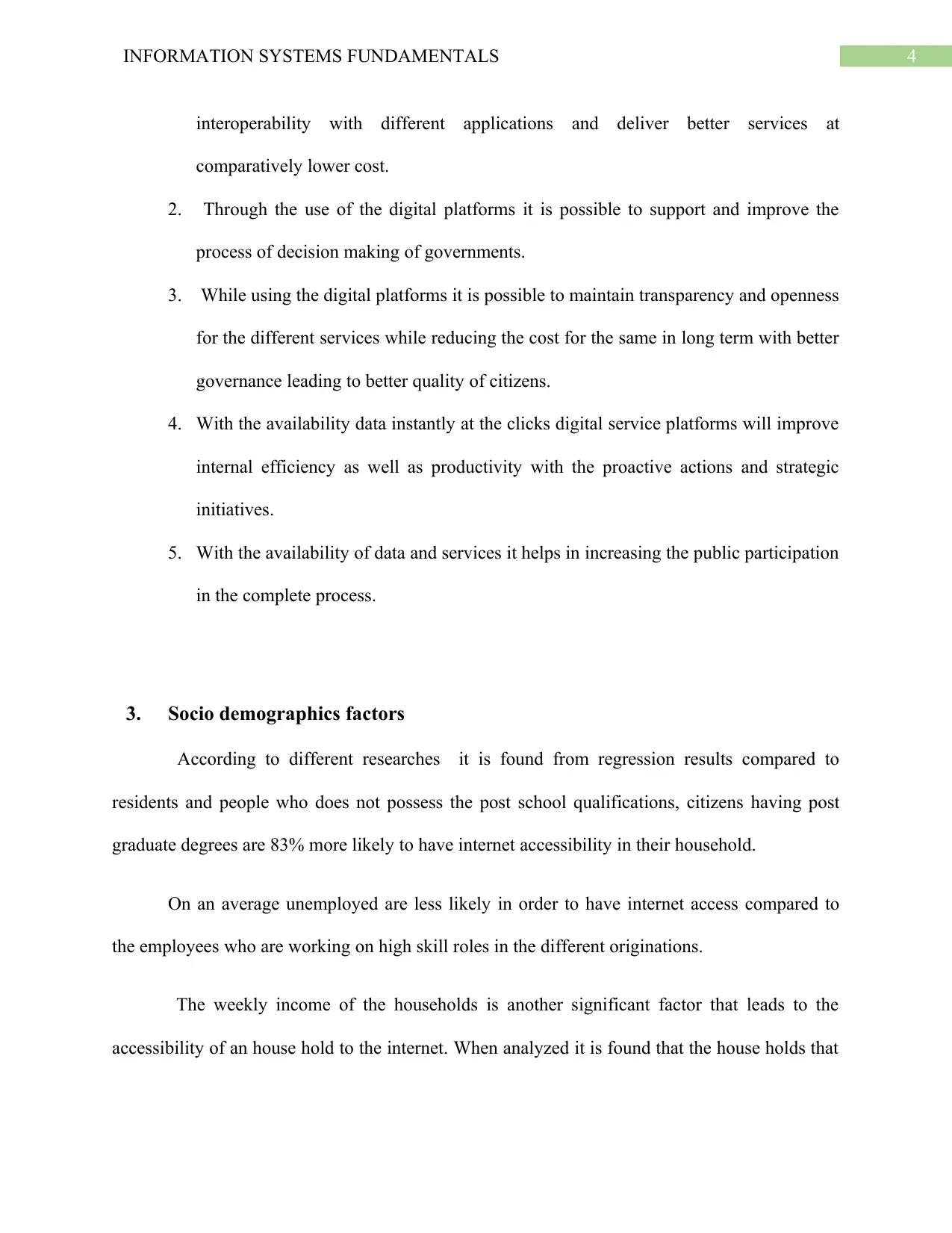
4INFORMATION SYSTEMS FUNDAMENTALS
interoperability with different applications and deliver better services at
comparatively lower cost.
2. Through the use of the digital platforms it is possible to support and improve the
process of decision making of governments.
3. While using the digital platforms it is possible to maintain transparency and openness
for the different services while reducing the cost for the same in long term with better
governance leading to better quality of citizens.
4. With the availability data instantly at the clicks digital service platforms will improve
internal efficiency as well as productivity with the proactive actions and strategic
initiatives.
5. With the availability of data and services it helps in increasing the public participation
in the complete process.
3. Socio demographics factors
According to different researches it is found from regression results compared to
residents and people who does not possess the post school qualifications, citizens having post
graduate degrees are 83% more likely to have internet accessibility in their household.
On an average unemployed are less likely in order to have internet access compared to
the employees who are working on high skill roles in the different originations.
The weekly income of the households is another significant factor that leads to the
accessibility of an house hold to the internet. When analyzed it is found that the house holds that
interoperability with different applications and deliver better services at
comparatively lower cost.
2. Through the use of the digital platforms it is possible to support and improve the
process of decision making of governments.
3. While using the digital platforms it is possible to maintain transparency and openness
for the different services while reducing the cost for the same in long term with better
governance leading to better quality of citizens.
4. With the availability data instantly at the clicks digital service platforms will improve
internal efficiency as well as productivity with the proactive actions and strategic
initiatives.
5. With the availability of data and services it helps in increasing the public participation
in the complete process.
3. Socio demographics factors
According to different researches it is found from regression results compared to
residents and people who does not possess the post school qualifications, citizens having post
graduate degrees are 83% more likely to have internet accessibility in their household.
On an average unemployed are less likely in order to have internet access compared to
the employees who are working on high skill roles in the different originations.
The weekly income of the households is another significant factor that leads to the
accessibility of an house hold to the internet. When analyzed it is found that the house holds that
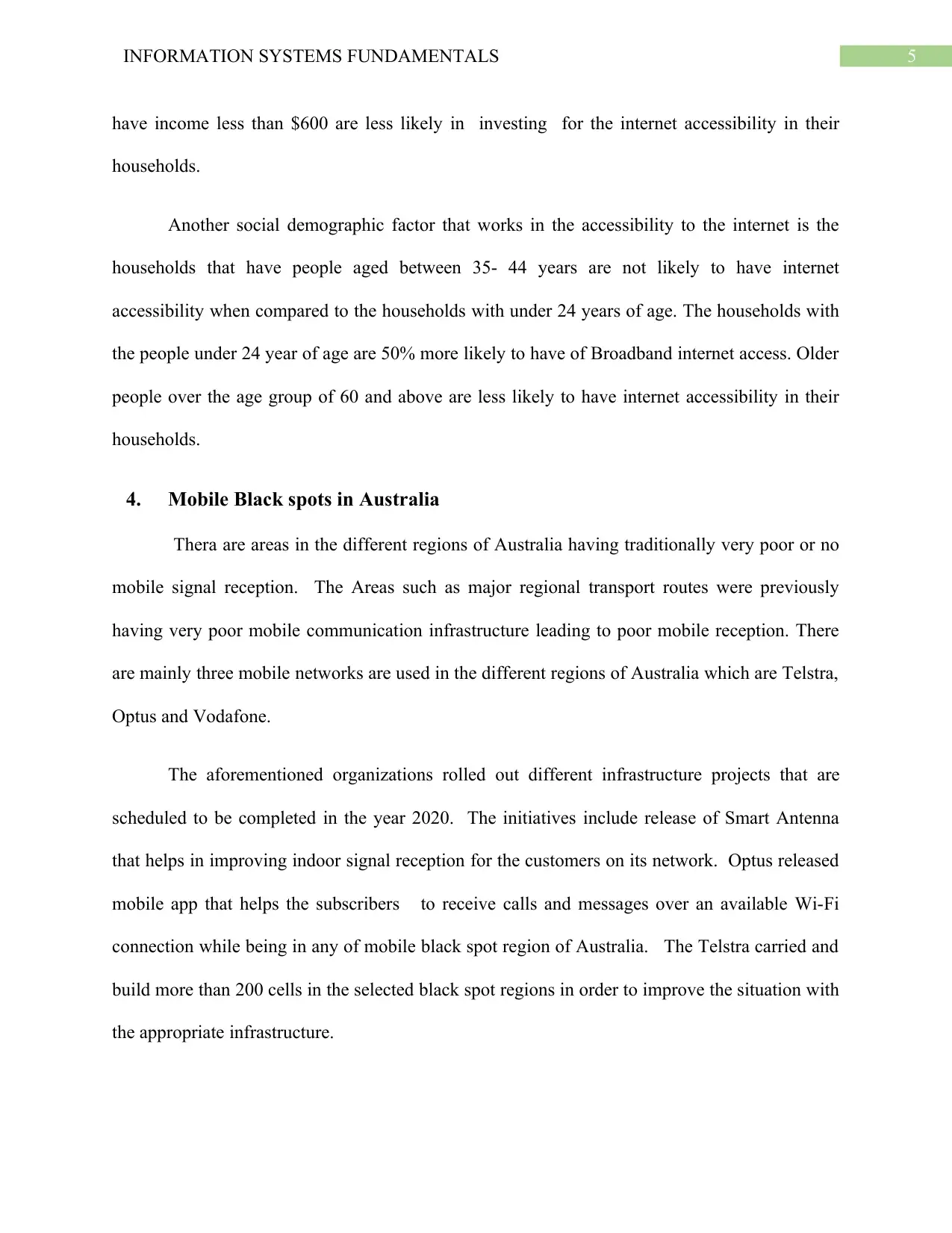
5INFORMATION SYSTEMS FUNDAMENTALS
have income less than $600 are less likely in investing for the internet accessibility in their
households.
Another social demographic factor that works in the accessibility to the internet is the
households that have people aged between 35- 44 years are not likely to have internet
accessibility when compared to the households with under 24 years of age. The households with
the people under 24 year of age are 50% more likely to have of Broadband internet access. Older
people over the age group of 60 and above are less likely to have internet accessibility in their
households.
4. Mobile Black spots in Australia
Thera are areas in the different regions of Australia having traditionally very poor or no
mobile signal reception. The Areas such as major regional transport routes were previously
having very poor mobile communication infrastructure leading to poor mobile reception. There
are mainly three mobile networks are used in the different regions of Australia which are Telstra,
Optus and Vodafone.
The aforementioned organizations rolled out different infrastructure projects that are
scheduled to be completed in the year 2020. The initiatives include release of Smart Antenna
that helps in improving indoor signal reception for the customers on its network. Optus released
mobile app that helps the subscribers to receive calls and messages over an available Wi-Fi
connection while being in any of mobile black spot region of Australia. The Telstra carried and
build more than 200 cells in the selected black spot regions in order to improve the situation with
the appropriate infrastructure.
have income less than $600 are less likely in investing for the internet accessibility in their
households.
Another social demographic factor that works in the accessibility to the internet is the
households that have people aged between 35- 44 years are not likely to have internet
accessibility when compared to the households with under 24 years of age. The households with
the people under 24 year of age are 50% more likely to have of Broadband internet access. Older
people over the age group of 60 and above are less likely to have internet accessibility in their
households.
4. Mobile Black spots in Australia
Thera are areas in the different regions of Australia having traditionally very poor or no
mobile signal reception. The Areas such as major regional transport routes were previously
having very poor mobile communication infrastructure leading to poor mobile reception. There
are mainly three mobile networks are used in the different regions of Australia which are Telstra,
Optus and Vodafone.
The aforementioned organizations rolled out different infrastructure projects that are
scheduled to be completed in the year 2020. The initiatives include release of Smart Antenna
that helps in improving indoor signal reception for the customers on its network. Optus released
mobile app that helps the subscribers to receive calls and messages over an available Wi-Fi
connection while being in any of mobile black spot region of Australia. The Telstra carried and
build more than 200 cells in the selected black spot regions in order to improve the situation with
the appropriate infrastructure.
⊘ This is a preview!⊘
Do you want full access?
Subscribe today to unlock all pages.

Trusted by 1+ million students worldwide
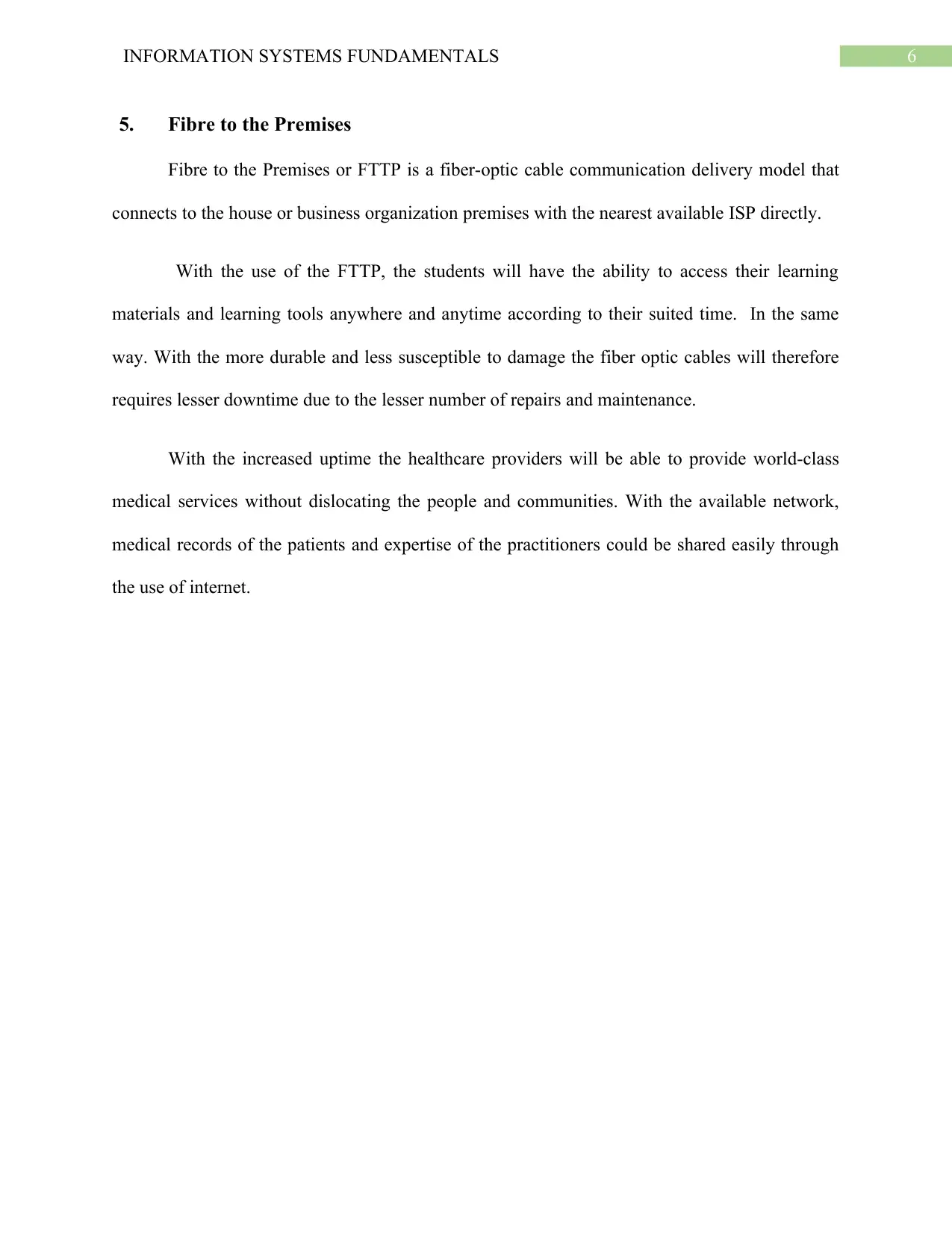
6INFORMATION SYSTEMS FUNDAMENTALS
5. Fibre to the Premises
Fibre to the Premises or FTTP is a fiber-optic cable communication delivery model that
connects to the house or business organization premises with the nearest available ISP directly.
With the use of the FTTP, the students will have the ability to access their learning
materials and learning tools anywhere and anytime according to their suited time. In the same
way. With the more durable and less susceptible to damage the fiber optic cables will therefore
requires lesser downtime due to the lesser number of repairs and maintenance.
With the increased uptime the healthcare providers will be able to provide world-class
medical services without dislocating the people and communities. With the available network,
medical records of the patients and expertise of the practitioners could be shared easily through
the use of internet.
5. Fibre to the Premises
Fibre to the Premises or FTTP is a fiber-optic cable communication delivery model that
connects to the house or business organization premises with the nearest available ISP directly.
With the use of the FTTP, the students will have the ability to access their learning
materials and learning tools anywhere and anytime according to their suited time. In the same
way. With the more durable and less susceptible to damage the fiber optic cables will therefore
requires lesser downtime due to the lesser number of repairs and maintenance.
With the increased uptime the healthcare providers will be able to provide world-class
medical services without dislocating the people and communities. With the available network,
medical records of the patients and expertise of the practitioners could be shared easily through
the use of internet.
Paraphrase This Document
Need a fresh take? Get an instant paraphrase of this document with our AI Paraphraser
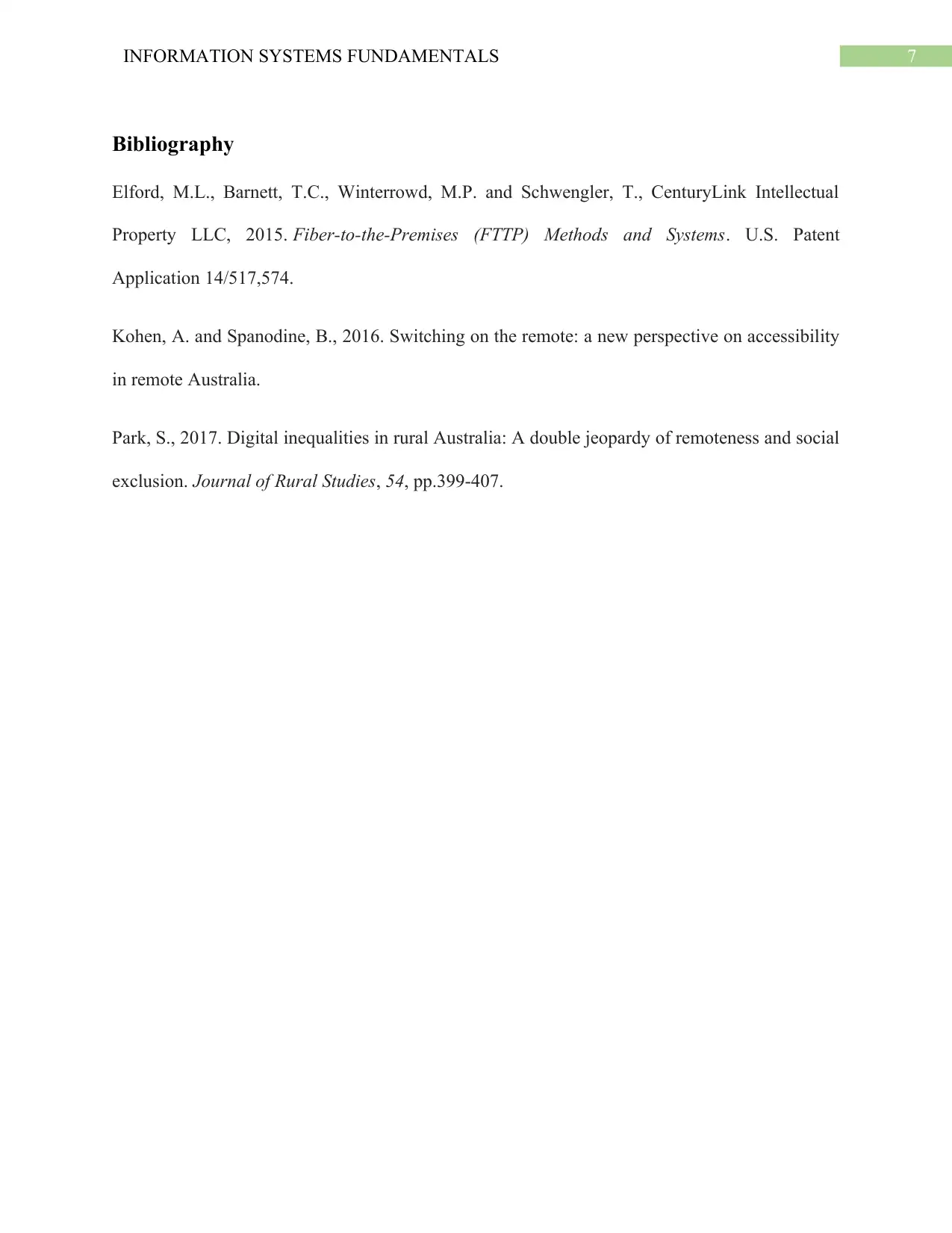
7INFORMATION SYSTEMS FUNDAMENTALS
Bibliography
Elford, M.L., Barnett, T.C., Winterrowd, M.P. and Schwengler, T., CenturyLink Intellectual
Property LLC, 2015. Fiber-to-the-Premises (FTTP) Methods and Systems. U.S. Patent
Application 14/517,574.
Kohen, A. and Spanodine, B., 2016. Switching on the remote: a new perspective on accessibility
in remote Australia.
Park, S., 2017. Digital inequalities in rural Australia: A double jeopardy of remoteness and social
exclusion. Journal of Rural Studies, 54, pp.399-407.
Bibliography
Elford, M.L., Barnett, T.C., Winterrowd, M.P. and Schwengler, T., CenturyLink Intellectual
Property LLC, 2015. Fiber-to-the-Premises (FTTP) Methods and Systems. U.S. Patent
Application 14/517,574.
Kohen, A. and Spanodine, B., 2016. Switching on the remote: a new perspective on accessibility
in remote Australia.
Park, S., 2017. Digital inequalities in rural Australia: A double jeopardy of remoteness and social
exclusion. Journal of Rural Studies, 54, pp.399-407.
1 out of 8
Your All-in-One AI-Powered Toolkit for Academic Success.
+13062052269
info@desklib.com
Available 24*7 on WhatsApp / Email
![[object Object]](/_next/static/media/star-bottom.7253800d.svg)
Unlock your academic potential
Copyright © 2020–2025 A2Z Services. All Rights Reserved. Developed and managed by ZUCOL.

